This article provides both visual and written instructions for setting up a new project.
Projects in Reveal are databases often equivalent to a specific legal matter, investigation, or analytical assessment. The Project is where users will review and classify documents for analytics and production.
A Company is required in order to create a new Reveal project. Users assigned to the company may then be assigned to projects created within that company and given appropriate role permissions. Clients can be created within the company as well to facilitate billing reporting.
This document will set out how to create and manage projects in Reveal.
Getting Started
An Instance or Company Administrator will open Reveal to this landing page listing currently available Projects (under Discovery) as a default for all users. Instance and Company Administrators will also see an Admin section in which they can administer Companies and, under each Company, its Users, Clients and Projects. Note that Instance or Company Administrators can see all projects in their purview, whether they are explicitly added to projects or not. Also note that the “Company Admin” link in the navigation sidebar is to the legacy Reveal Company Admin area only.
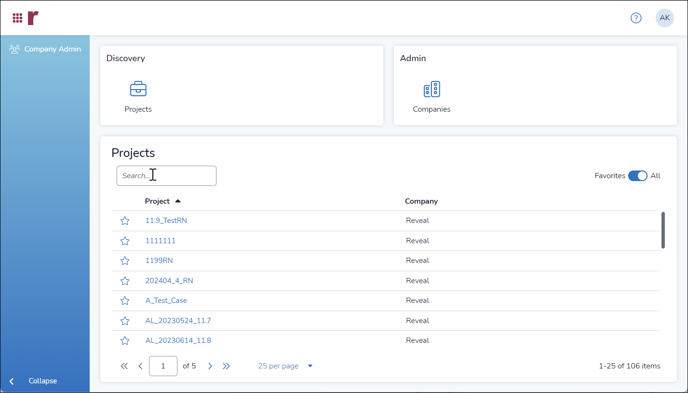
On this initial administrator landing page you may use Search to filter the list based on Project Name. You can click a star next to a project to mark it as a favorite which displays it by default on opening Reveal, or when toggling between the Favorites and All selector.

To create and manage Projects, an administrator must be in the Admin > Companies > [Company] area. Note that this also means that a Project listed under a Company’s Projects cannot be opened directly from there.
Setting Up Projects
- Open Companies in the Admin box on the landing page.

- In the Companies screen, select the company whose projects are to be administered. This will open to the company’s Overview screen.
- Click Projects in the Company screen navigation bar to create, configure and populate matters for Reveal.
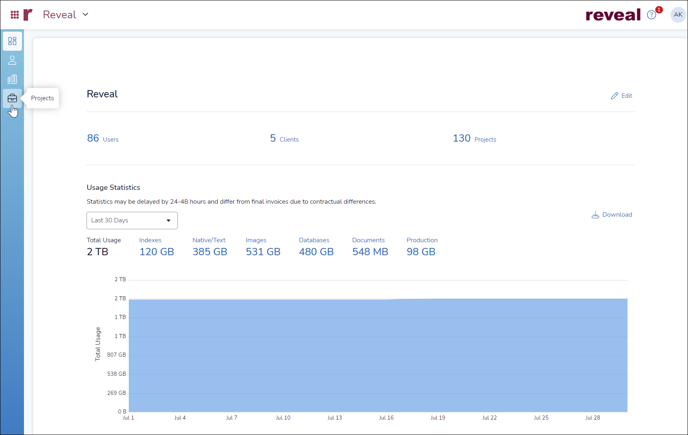
- The Projects screen displays, in addition to the +Add Project button and Search filter:
- Name of project, sortable by clicking the heading and searchable. Clicking the project name will open the project details, not the project itself, as noted above.
- ID is the unique identifier of the project.
- Documents is the current total number of documents in the project database.
- Status shows whether the project is Active or in Cold Storage. Cold Storage, new in Reveal 2024.7, takes a project offline so that it cannot be opened and makes it invisible to users other than administrators, in order that the project not be billed if in Cold Storage for the entire month. If requesting or implementing Cold Storage, please check with your consulting or sales representative as to process and implications. This will be discussed further under Managing a Project below.
- Edit opens the project details for editing.
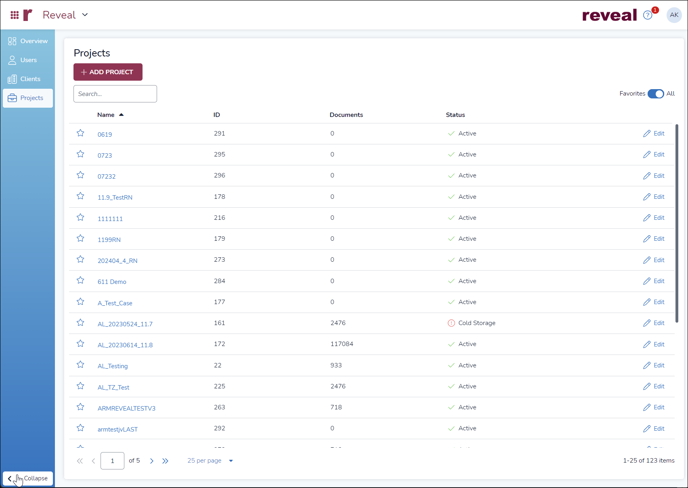
- You may click Add Project to enter the following information:

- Name - {required} The project name. NOTE that project names may be descriptive labels that include spaces, but not any of the following characters: : * ? \\ / < > | "
- Id – {required} Short alphanumeric identifier for the project.
- Company – {required} Sets the company within which the project is created for Reveal and Processing.
- Client – {required} Sets the client within which the project is created for Reveal and Processing.
- Features – There are two checkboxes here, neither checked by default:
- Enable Document-Level Security to extend Reveal security for Document Access to individual documents.
- Use as Template for Future Projects to name and reuse these project settings.
- Time Zone - {required} Sets the time zone for project data in Reveal and Processing to automatically normalize email metadata shown in HTML, extracted text and tiff-on-the-fly views to match the time zone that is set for your project here. Reveal will also normalize email metadata shown in images when performing a production or print job. NOTE: The time zone cannot be changed after case creation.
- Processing Template – Select an existing Processing project template from the drop-down menu.
- Save when completed.
- A create project status box will open and display the progress of the various stages during the creation of a Reveal project. This includes its processing, database, and analytics components. When complete, the project can be loaded and is ready to be populated with data for review.

Managing a Project
As noted above, a Reveal Project is managed under Admin > Companies > [Company] > Projects in the user interface. There is also the legacy Company Admin area, which offers project Peak Billing Info and Case Status reports. Below we will set out the access and use of each project administration area and its tools.
Updated Companies > [Company] > Project Interface
- Open Companies in the Admin box on the landing page.
- In the Companies screen, select the company whose projects are to be administered. This will open to the company’s Overview screen.
- Click Projects in the Company screen navigation bar.
- To open a project, click on its Name. This will open a project summary view presenting:
.png?quality=high&width=688&height=466&name=203%20-%2007%20-%20Project%20Summary%20Screen%20(New).png)
- The project ID (not editable).
- The Company (linked).
- The Client (linked).
- Time Zone – set at project creation, not editable.
- Edit (which may also be opened from the Edit control at the right of the project’s table entry). The only project items that may be updated here are:

- The Name.
- Enable Document-Level Security checkbox.
- Use as Template for Future Projects checkbox. - Usage Statistics for the various storage categories – TOTAL, Indexes, Native/Text, Images, Databases, Documents and Production – are presented as figures, graphically, and are available for download, currently only for the last 30 days.

- Cold Storage is the last item on the screen. As noted above, Cold Storage takes a project offline so that it cannot be opened making it invisible to users other than administrators. The project will not be billed if it remains in Cold Storage for the entire month. If requesting or implementing Cold Storage, please check with your consulting or sales representative as to process and implications.
- To place a project in Cold Storage, click the Move to Cold Store button at the bottom of the project summary screen. You will be asked to confirm.
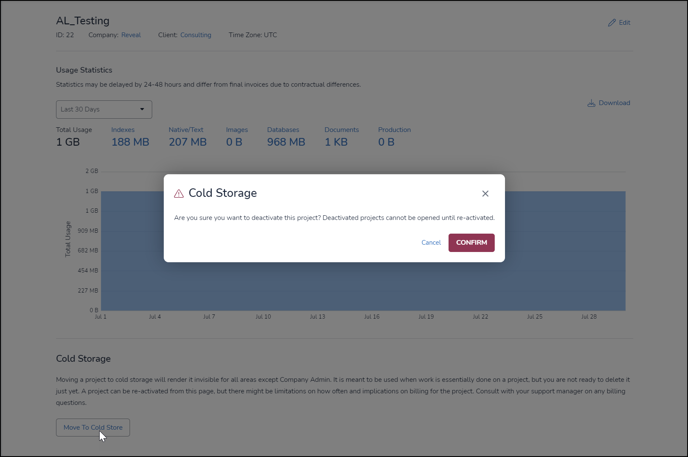
- Once deactivated, the projects summary statistics will clear from the screen, though this data still exists on the back end.
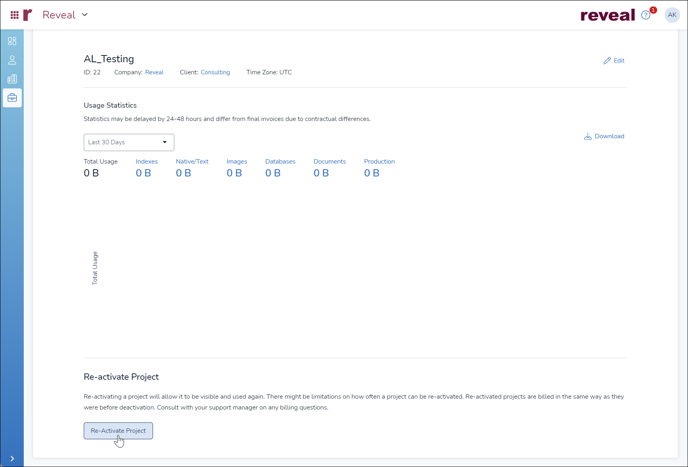
- To exit the project summary screen, click the Projects button in the navigation sidebar.
- The project status will now show Cold Storage. Only administrators will see this.

- To re-activate the project, open the project screen and click Re-activate Project. You will be asked to confirm.

- The project will be fully enabled with all data, users and settings as previously. Note that a project will be fully billable for any part of a month in which it is Active, even if only part of a single day.
- To place a project in Cold Storage, click the Move to Cold Store button at the bottom of the project summary screen. You will be asked to confirm.
NOTE: Projects may be moved into and out of cold storage as often as needed, with no limits. Users are locked out instantly when the project is moved into cold storage and receive access back instantly upon re-activation with all permissions intact. Only a browser refresh may be required on the user’s part to re-enter the project. Usage tracking does not change and all logs are maintained. The only thing that changes is a flag indicating whether the project was in cold storage for that day.
Legacy Company Admin > Projects Interface
- Log in to Reveal as an Administrator.
- Select Company Admin at the landing page sidebar.
- The opening Projects tab lists all the current projects; the Summary pane on the right provides information for the amount of data utilized. Any column in the table may be filtered by example. The columns displayed are:
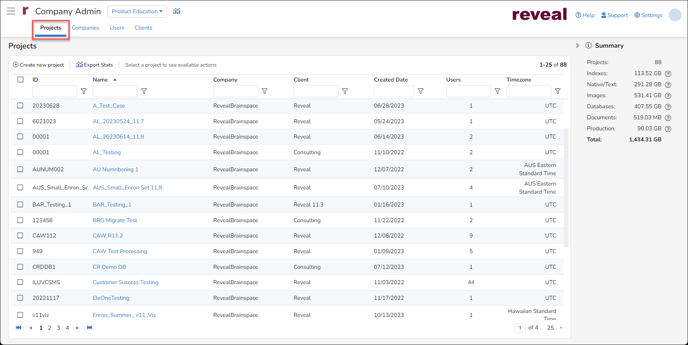
- ID – A unique alphanumeric identifier for the project.
- Name – The project’s descriptive name is a clickable link to the project detail screen.
- Company – The company under which the project was created.
- Client – The company client under which the project was created.
- Created Date – The date on which the project was created.
- Users – The current number of users actively assigned to the project.
- Timezone – The normalized time zone setting for the project; this value cannot be changed.
- In addition, there are two controls above the Projects table if no projects are selected:
- Create new project – Another way to access the project creation workflow described above.
- Export stats – Choose which project report to generate:
- Peak Billing Info – Selecting this will prompt for a Start Date and an End Date to report maximum usage over the specified period.
- Case Stats – Outputs project table data plus storage statistics in each Summary category for each project.
- If a project in the table is selected (or multiple projects are selected), additional controls are displayed above the table:

- Create new project.
- Export stats.
- Show stats – Displays a pop-up report of storage statistics for the project(s) selected.
- Details – Opens the Project Details screen, the same as clicking on the Project Name in the table.
- Edit – Opens the project directly to its Edit screen for updating.
- Delete – Removes the selected project(s). It is advised to apply this action with extreme caution only after verifying that no useful active data exists in the project.
- To view and manage a project click on the Project Name in the Projects table. The Project details screen displays:

- The case name at the top with the Case ID and Company in the header;
- A listing of all Users assigned to the case with the assigned Team(s) and Role of each; and
- Summary case statistics in the shaded pane to the right.
- To manage project users or settings click Edit at the upper right of the screen.
- In the Edit Project screen the administrator may view the Project Name, ID and Time Zone; these values may not be changed after the project is created. Items which may be edited for the Project are:
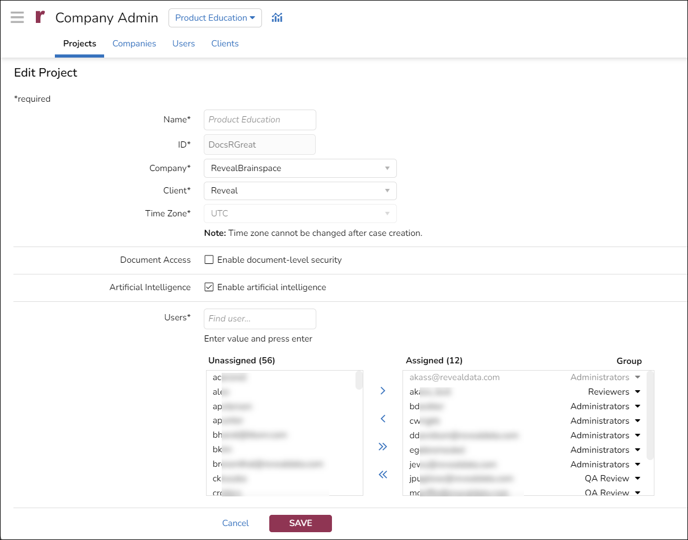
- Name is the display name of the project, which cannot be amended.
- ID is the internal identifier of the project, which cannot be edited.
- Company selects the Company with which the Project is associated.
- Client selects the Company Client with which the Project is associated.
- Time Zone for the project may be viewed but not changed.
- Document Access sets document level security on or off.
- Artificial Intelligence sets access to AI analysis; this is set ON by default.
- Users is where available users may be assigned to or removed from the project. Users assigned must have a security group specified in order to access the project. See How to Create & Manage Users for more information.
- Click SAVE when modifications are complete.
Last Updated 10/17/2024
